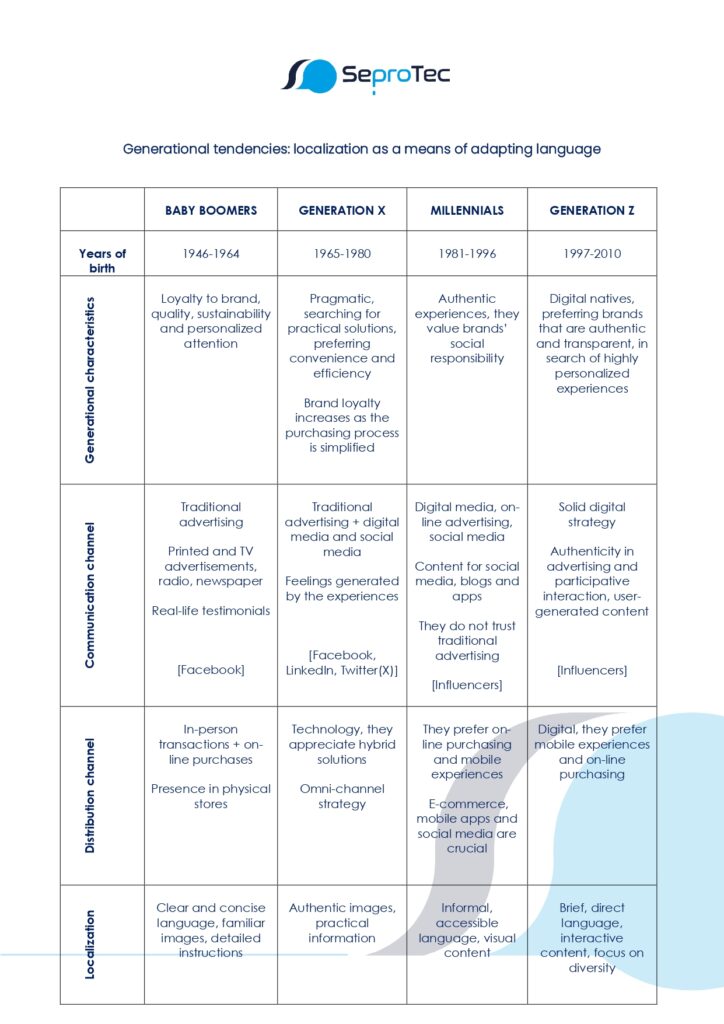
Generational tendencies: localization as a means of adapting language
At present, the consumer landscape is one of generational diversity, each generation with its particular characteristics, values and preferences. From Baby Boomers through to Generation Z, via Generation X and the Millennials. Generations do not emerge from a vacuum, but are the product of shared experiences, historical events and cultural influences that mold the mindset and behaviors of their members.
Understanding the distinctive characteristics of each generation is essential for any business that aspires to establish effective ties with its target customers. From the development of communication strategies and product design through to the implementation of marketing techniques and customer service.
Adapting to the preferences and values of each demographic segment can make all the difference between success and failure in an ever more competitive and diversified market. What’s more, in this context localization emerges as a crucial factor in language adaptation for addressing the different generations.

Generational characteristics
Today’s consumers come from four distinct generations. Baby Boomers, Generation X, Generation Y, better known as Millennials, and Generation Z – each generation has different preferred ways of communicating and consuming, which businesses need to understand in order to address them effectively. For example, Baby Boomers (those born between 1946 and 1964) prefer direct, detailed communication and personal service, whereas members of Generation X (1965-1980) prefer formal and flexible communication, favoring practical and pragmatic options. Millennials (born between 1981 and 1996) value authenticity, efficiency, speed and digital communication, and seek brands that demonstrate social responsibility and offer genuine experiences. Members of Generation Z on the other hand (those born between 1997 and 2010) seek clear and direct communication, value face-to-face interaction and are looking for brands that are authentic, honest and offer personalized experiences.
Communication channel
To connect effectively with the various age groups, it is important to bear in mind the communication channels that each generation prefers.
Baby Boomers value tradition and familiarity. They therefore prefer traditional communication channels such as printed advertising, TV commercials, radio and newspapers, they tend to trust real-life testimonies and find authenticity in traditional advertising.
Generation X on the other hand has shown a preference for a combination of traditional advertising, digital media and social media. This group appreciates the feelings generated by significant experiences and feels attracted mainly by campaigns that affect them personally.
Millennials are drawn strongly to digital communication channels, which implies on-line advertising, social media content, blogs and apps as the main means of interaction. They are skeptical as regards traditional advertising and seek genuine ways of connecting with brands. Furthermore, they tend to trust the recommendations of influencers on social media, and this has a significant effect on their purchasing decisions.
Digital natives (Generation Z) have a clear preference for communication channels based mainly on solid digital strategies. This age group sets great store by authenticity in advertising and seeks participative interaction with the brands. They also tend to consume user-generated content, and, like Millennials, they are greatly influenced by “influencers”.
Distribution channel
Baby Boomers tend to prefer purchases in physical stores over on-line purchases. They appreciate the personal service and the tangible experience provided by physical stores. For their part, members of Generation X prefer a mixed approach to their purchases, combining the convenience and accessibility of on-line purchases with the personal service and the experience of physical stores. Today’s young people, including Millennials and Generation Z, favor convenience, speed and accessibility, and prefer on-line purchases and mobile experiences, using social networks and mobile apps to find and buy products and services. Despite the gradual shift toward on-line purchases, the older generations continue to prefer going to a physical store where they can examine the products and receive direct assistance from the sales staff, whereas the younger generations attach more importance to efficiency and personalization, finding in the digital environment the perfect place for their consumer needs.
Why is localization important as a way of adapting language in this area?
When communicating with different generations, it is important to recognize the value of localization. Each generation has its own way of talking, and this linguistic process helps to adapt content in order to connect with different cultural groups. This can facilitate a more effective connection between customers and the business.
Due to the co-existence of four generations in the current consumer landscape, communication can be a challenge, especially for businesses that offer products or services aimed at several generations. To create an effective localization strategy, businesses need to understand the needs and preferences of each generation as regards communication.
The process of “localizing” content for the target customer group becomes more difficult when we also have to do it in another language. This is not a matter of just translating the content, but rather of completely adapting it to the target. This approach ensures that the content reaches each demographic group naturally and effectively, facilitating an authentic, significant connection with the target group.
Language service providers (LSPs) such as SeproTec Multilingual Solutions play a crucial role in bridging the generation gap in both the internal and the external communication of a business. By taking advantage of the translation and localization services provided by professional translators, businesses can ensure that their content is not only accessible, but also that it reverberates among employees and customers worldwide.

There are no comments



Leave a comment